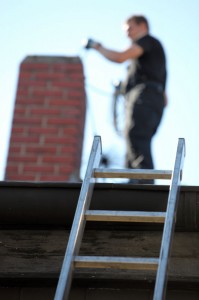As the reality of colder temperatures gets closer, many homeowners have begun to think about their fireplaces for the first time since spring. While fireplaces and chimneys are built to withstand the elements, effective annual maintenance is a way to guarantee that they will continue to work their best for years to come.
Disuse during warmer months often leaves chimneys and fireplaces unprepared for the first cozy fires of the fall. Because of this, it is recommended that homeowners have their fireplaces and chimneys inspected before they begin using them each season.
How often should chimneys be cleaned or inspected?
Although fireplace and chimney maintenance often takes a backseat to other home improvement projects, it is important that these systems are annually inspected to ensure they remain structurally sound and are safe to use. According to the National Fire Protection Association, “Chimneys, fireplaces, and vents shall be inspected at least once a year for soundness, freedom from deposits, and correct clearances. Cleaning, maintenance, and repairs shall be done if necessary.”
Based on this standard, the CSIA, or Chimney Safety Institute of America, recommends that chimneys, flues, and fireplaces be cleaned at least once per year. While an annual cleaning and inspection may seem excessive, it is a necessary part of correct fireplace maintenance. Annual sweepings prevent the buildup of creosote, a flammable buildup created by wood-burning fires, and excessive soot, which can have a permanent, damaging effect on the fireplace masonry. In addition, an annual inspection ensures that small problems can be found and fixed before they turn into larger – and costlier – issues.
What to expect during an annual inspection
For homeowners whose chimneys and fireplaces receive regular maintenance and cleaning, the chimney sweep will likely perform a basic, Level I inspection. In addition to the cleaning process, the technician will inspect all accessible parts of both the exterior and interior of the chimney, including the masonry of the chimney structure and the fireplace hardware. The flue and chimney will also be checked for any signs of debris of blockages. Lastly, the technician will measure the amount of creosote present in the chimney, ensuring that this highly-flammable byproduct of wood-burning fires is completely removed.
In the event that a problem is uncovered during the inspection, a more in-depth Level II or Level III inspection can be performed. The highly skilled technicians at Pristine Sweeps are trained to not just find and diagnose a problem, but to complete the necessary fireplace and chimney repairs.
The importance of preventative maintenance
One of the most important steps homeowners can take to increase the longevity of their fireplaces is to have regular preventative maintenance done. While an annual inspection and cleaning might seem like an unnecessary expense – especially for those who do not regularly use their fireplaces – doing so can often prevent the necessity of costly repairs.
By investing in preventative maintenance measures such as waterproofing, a new or repaired chimney crown, or tuckpointing to repair damaged mortar, homeowners can rest assured that their fireplaces will continue to provide them with a warm atmosphere and ambiance year after year.

